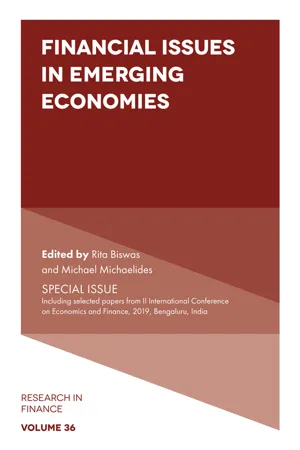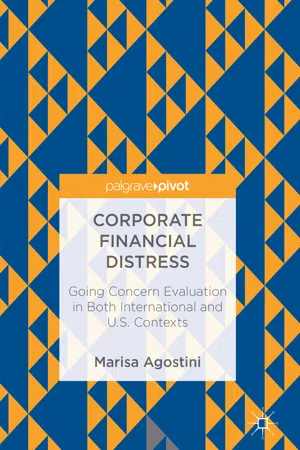Financial Distress
Financial distress refers to a situation where a company is unable to meet its financial obligations, such as debt payments or operational expenses. This can lead to a decline in the company's performance, potential bankruptcy, or the need for financial restructuring. Signs of financial distress include cash flow problems, declining profitability, and high levels of debt.
7 Key excerpts on "Financial Distress"
- eBook - ePub
Financial Issues in Emerging Economies
Special Issue Including Papers from the International Conference on Economics and Finance, India
- Rita Biswas, Michael Michaelides, Rita Biswas, Michael Michaelides(Authors)
- 2020(Publication Date)
- Emerald Publishing Limited(Publisher)
...This is consistent with the definition introduced by Aston and Ngwa (2016) which indicates that the concept “Financial Distress” is used to reflect the financial situation in which a company suffers from lack of liquidity which in turn decreases the ability of the company to pay its financial obligations on a maturity date and these liquidity problems cannot be solved without restructuring of its operations (p. 10). In line with the previous discussion, Geng et al. (2014) confirm that Financial Distress is a comprehensive concept which involves multiple situations in which companies face financial problems. Consequently, researchers in finance tried to define the meaning of distress depending on their different criteria. For example, in banking sector, John, Adaeze, Son, and Onoriade (2012) define Financial Distress as “sizeable percentage of financial institution have liabilities exceeding the market value of their assets which may lead to collapse in financial system” (p. 237). Platt and Platt (2002) defined Financial Distress as “a late stage of corporate decline that precedes more cataclysmic events such as bankruptcy or liquidation” (pp. 184–185). While Chan and Chan (1991) defined the meaning of distressed firms as firms that lost their market value because of poor performance, they are most likely to have high financial leverage and they have cash flow problems, and their prices tend to be more sensitive to changes in the economy. Based on the previous discussion, literature in Financial Distress has introduced inconsistent measures of when corporations enter distress stage. According to Tinoco and Wilson (2013), most prior research in Financial Distress utilizes specific events such as bankruptcy as a criterion to define Financial Distress. Therefore, the probability of distress can be easily modeled by distinguishing between failed and non-failed firms. However, depending on a legal definition of bankruptcy involves some issues...
- eBook - ePub
Synergizing Management, Technology and Innovation in Generating Sustainable and Competitive Business Growth
Proceedings of the International Conference on Sustainable Collaboration in Business, Information and Innovation (SCBTII 2020), Bandung, Indonesia, July 10, 2020
- Ratih Hendayani, Indira Rachmawati, Hani Gita Ayuningtias, Cahyaningsih, Dania Syanetta Dennyra, Ratih Hendayani, Indira Rachmawati, Hani Gita Ayuningtias, Cahyaningsih, Dania Syanetta Dennyra(Authors)
- 2021(Publication Date)
- Routledge(Publisher)
...Formerly, Platt and Platt (2002) defined Financial Distress as a condition in which a company’s finances are unhealthy or in crisis. Elloumi and Guyie (2001) categorize companies with Financial Distress if they experience negative net income for two consecutive years. Bankruptcy is not always the case, but when it becomes real, it can have a direct impact on companies, both economically and socially (Kristanti & Herwany 2017). The purpose of this study was to determine the variables of financial risk, operational risk, profitability, lending interest rate, inflation and Financial Distress in telecommunications companies in the Asia Pacific, in the 2013–2017 period. 2 LITERATURE REVIEW Financial Distress is a condition where a company faces a certain financial problem. According to Platt and Platt (2002), Financial Distress is defined as a stage of decline in financial conditions that occurred before the bankruptcy or liquidation. According to Wruck (1990), Financial Distress is a situation where cash flow operations are inadequate to meet current liabilities such as debt trade or interest costs (Aiyabei 2002). Some research on bankruptcy focuses on the use of financial ratios as a predictor of Financial Distress. Altman (1968) used the Z score as a tool to predict bankruptcy probability. Ohlson (1980), Zmijewski (1984), and Lau (1987) used the same prediction model but with different financial ratios. 2.1 Financial perspective Boritz (1991) describes the process of Financial Distress that begins with an incubation period conditioned by poor economic conditions and management, which takes the wrong financial decisions. In this situation, companies experiencing negative earnings per share (EPS) in the long run are considered to be in Financial Distress. Kristanti et al...
- eBook - ePub
Corporate Financial Distress
Going Concern Evaluation in Both International and U.S. Contexts
- Marisa Agostini(Author)
- 2018(Publication Date)
- Palgrave Pivot(Publisher)
...Flagg et al. (1991) were among the first to consider a sample of exclusively distressed firms and identify four events (i.e. reductions in dividends, “going concern” qualified opinions, troubled debt restructurings, and violations of debt covenants) signalling that a firm is experiencing Financial Distress. Chen et al. (1995) were then among the first to define distress as the condition where a firm’s liquidation of total assets is less than the total value of creditor claims. If prolonged, this situation can lead to forced liquidation or bankruptcy ; for this reason, Financial Distress is often referred to as the likelihood of bankruptcy, which is dependent on the availability of liquidity and credit (Hendel 1996). Pindado et al. (2008) introduces a dynamic proxy of corporate Financial Distress that is independent of the (final) outcome (e.g. bankruptcy) while still based only on financial symptoms. This approach classifies a company as financially distressed whenever its operational cash flows are lower than financial expenses and market value persistently falls. Focusing on the early stages of Financial Distress, rather than predicting an eventual bankruptcy, has progressively become a prime concern of the academic literature. The role of time extension is a significant recognition (Balcaen and Ooghe 2006), but still represents only a first step forward for defining corporate Financial Distress. Such distress implies a lengthened pathological condition for firms in which the term “financial” describes its main consequences. Therefore, corporate Financial Distress can be defined as a negative lasting situation during which a firm experiences bad financial conditions such as low liquidity, inability to pay debts, restriction on dividend distribution policy, increase in the cost of capital, reduction in access to external funding sources, and weaker credit ratings...
- eBook - ePub
Corporate Financial Distress
Restructuring and Turnaround
- Alberto Tron(Author)
- 2021(Publication Date)
- Emerald Publishing Limited(Publisher)
...Financial Distress can be defined as the point where cash flows are lower than the firm's current obligations (Wruck, 1990). If a company is unable to meet those obligations, it is in default (Vassalou & Xing, 2004) and its creditors may start legal proceedings to sue for bankruptcy. This book provides evidence on distressed firms (Chapter 2) from a civil-law country, Italy, that has traditionally been considered a country with rather weak shareholder and quite strong creditor protection (La Porta, Lopez-de-Silanes, Shiefer, & Vishny, 1998). Most existing studies have so far almost exclusively looked at the US (Altman & Hotchkiss, 2005); however, the US has a financial market that is usually characterised by stronger shareholder and weaker creditor rights if compared to Italy. Differences in legal regimes are likely to matter for changes in corporate oversight and turnarounds. For an Italian company in distress and heading towards default there are three options: (1) make a deal with creditors, possibly renegotiating obligations. (2) voluntarily file for bankruptcy, and either be auctioned off as a going concern or liquidated and sold piecemeal. (3) file for corporate reorganisation at the local district court. Independently of the local legal regime, this area has become of public concern due to the recent global financial crisis (2008–2009) that witnessed failures of many venerable institutions which were rescued by governments (Bear Stearns, AIG, Fannie Mae & Freddie Mac, Washington Mutual, Anglo Irish Bank, Royal Bank of Scotland, Northern Rock, etc.). The resolution mechanisms for both the...
- eBook - ePub
Private Capital Investing
The Handbook of Private Debt and Private Equity
- Roberto Ippolito(Author)
- 2019(Publication Date)
- Wiley(Publisher)
...It is difficult for investors to protect themselves against such liabilities. Performance materially below expectation: the most common reason for Financial Distress is that the company performs less well than expected. There are various reasons why performance can fall below expectations: Economic downturn: economic cycles, including recessions, are unavoidable. Few businesses are entirely protected against economic downturns. However, the challenge for the distressed investor is to determine whether this is the true cause of the distress – it is easy to blame the economy when things get tough. But is the problem the economy, or is it the management? Uncompetitive product or service: because no business is static and due to rapid technological progress, it is possible that businesses that once satisfied consumer needs may be rendered obsolete by advances in technology. Therefore. when a business starts to deteriorate, it will be necessary to examine whether the product or service being offered is still viable. Crisis of confidence: these are usually linked to fraud and other events that create financial uncertainty (e.g. WorldCom, Enron). There are two main issues to focus on when the crisis of confidence event occurs: Reliability of historical financial information: discoveries of fraud or the need for accounting restatements obviously render historical financial data questionable. Once any particular data has been called into question, all the remaining data should be viewed with scepticism. Nevertheless, it is important to carefully analyse the nature of the alleged issue to see if it is still possible to make a valuation, however tenuous that valuation might be. Liquidity and likelihood of bankruptcy: it is important to consider whether the information event in question will lead to a major liquidity crisis or to a bankruptcy...
- eBook - ePub
Distressed Debt Analysis
Strategies for Speculative Investors
- Stephen Moyer(Author)
- 2004(Publication Date)
- J. Ross Publishing(Publisher)
...CAUSES OF Financial Distress AND THE RESTRUCTURING IMPLICATIONS Thus far, Financial Distress has been simplistically viewed as the asset box becoming smaller than the debt box (see Figure 3-7). Logically, the asset/liability asymmetry can also arise from ballooning liabilities. Moving from the conceptual to the practical, the reasons behind the asymmetries have significant implications for investment analysis. This chapter considers many of the more common causes of Financial Distress and how they affect the analysis of the investment. First, however, some general indicators of Financial Distress are described as tools to help identify which situations merit attention. The concept is to first determine which situations are likely to be distressed and then to diagnose the reason for the distress and how that impacts the investment decision. Organizationally, concepts will be developed and then reinforced and built upon with more detailed discussion and examples. INDICATORS OF Financial Distress There are at least three general methodologies the distressed investor can use as a “screening” tool for identifying the firms that are likely to encounter Financial Distress: debt ratings, predictive statistical models, and market prices. Each of these will be briefly discussed, but it should be noted at the outset that by themselves these indicators have only limited utility to the distressed investor for two reasons. First, the critical investment issue is not whether a firm is in Financial Distress, but whether the market value of its securities is appropriate relative to its actual or potential asset value. Identifying whether a firm is in distress represents only the first step in the analysis. Second, these indicators, with the possible exception of the predictive models, are not particularly oriented to helping the investor be the first to identify a potential situation...
- eBook - ePub
Commercial Lending
Principles and Practice
- Adrian Cudby(Author)
- 2018(Publication Date)
- Kogan Page(Publisher)
...09 Businesses facing financial difficulties INTRODUCTION Businesses can sometimes face financial difficulties, perhaps through no fault of their own, and this chapter deals with the issues that banks and their customers face when this happens. It also discusses the choices and options facing both the bank and the customer and covers the various insolvency routes available. The bank is one of a number of stakeholders that will be concerned when a business isn’t performing financially as it should be. The risk, that you, as a banker, face is that the lending you have made will either not be repaid at all, or only repaid in part, resulting in a bad debt for the bank and where all or part of the monies lent will need to be written off. The other stakeholders in the business will include staff, trade creditors (including suppliers), HMRC (tax and VAT), possibly other banks and, of course, the owners of the business themselves. LEARNING OBJECTIVES By the end of this chapter, you will be able to: assess the warning signs for banks that indicate a commercial customer is in financial difficulties; explain how businesses get into financial difficulties; evaluate the choices commercial businesses have to deal with their financial difficulties; assess the different choices and options that face the lending banker; define insolvency; and apply the main insolvency procedures for personal and commercial customers. How do businesses get into financial difficulties? There are many reasons why businesses get into financial difficulties and some of these can be due to external factors outside the control of the business. Sometimes as a banker, you may see the decline of a business due to the change in tastes of customers or, in many cases, new technology. Such changes can have enormous impacts on existing business models...






